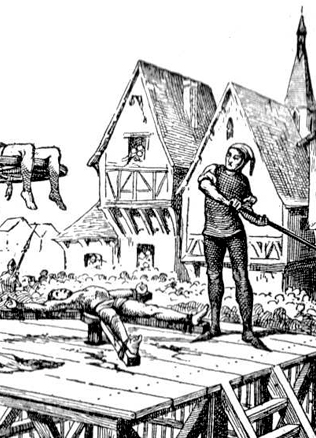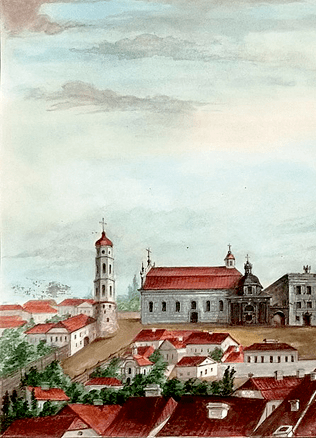Mead Fraternities
Urban society worked and spent its free time in different ways. It could well be regarded as a corporate (group) society. Various groups, both religious and professional (workshops and guilds) as well as the elite (King Arthur’s and other) counted as important forms of social organization. Orthodox mead fraternities as a specific form of urban social organization was a unique page in the history of the Orthodox and the mead. In the 15-17th centuries, such fraternities were functioning in the towns inhabited by the Orthodox. In the present-day territory of Lithuania, the only location of this type was Vilnius. In Belarus, the Orthodox were prevalent in Polotsk, Vitebsk, Minsk, Mogilev, Dysna, Veliz and elsewhere. In Poland, these were the territories which had once belonged to the GDL and after the Lublin Union were ceded to Poland as Podlaskie towns of Przemysl, Javorova and Volhynia, known for the Orthodox communities. In the 18th century, these fraternities started to be controlled by the clergy, which restricted consumption of alcoholic beverages. As a result, mead fraternities lost the spirit of “mead brotherhoods.” The term “mead fraternities” (Ruthenian медовые братцтва, Polish bractwa miodowe ruskie) was not coined by historians, it was used in the 17th century documents, e.g. in the documents from 1610, 1633.
Charity Drinking-Bouts
In historiography, these fraternities are often wrongly referred to as to as guilds or ecclesiastical fellowships. Actually, they should be regarded as rather specific secular societies, prevalent among Orthodox Christian adherents, serving the need of satisfying their recreational, religious, economic, philanthropic and other social needs. The main activities of such fraternities was the production and consumption of mead. Therefore, during the flowering period of these organizations (up until the late 16th-early 17th century) they performed the function of specific intermediate social structures rather than that of workshops or religious societies.
The genesis of mead fraternities was observing religious Orthodox rites and rituals, such as funerals, memorial rites, etc., when mild alcoholic beverages were consumed. Mead fraternities were exempt from customs duties for the revenue gained from mead production and trade. For the funds received, candles in Orthodox churches were moulded and donated to churches, fuel in the hospices of that time bought, food for the poor provided, etc. Unlike the case of religious fraternities, no women were allowed to join mead fraternities. When rituals observed, an abundance of mead was consumed. Following Orthodox traditions, men observed rituals separately. During such celebrations, excessive alcohol was often consumed, which gave rise to skirmishes, at times leading to fights.
There was no place for women in fraternities, the main activity of which was mead production and consumption.
Therefore, the aforementioned fraternities could not be compared to Orthodox Christian brotherhoods, which contributed significantly to the development of Orthodox education. To illustrate the point, the Mead Fraternities did not publish books, neither did they establish schools. On the other hand, they were not an equivalent to tobacco or alcohol lovers’ club. The most important element of these fraternities was mead. Apparently, mead wine was more related to the sphere of sacrum than profanum, as was the case with aqua vitae (vodka).
Spirit of fellowship among mead lovers
Vilnius Orthodox mead fraternities, the number of which was numerous in the capital of GDL was most numerous, must have been best explored. In the mid-15th-late 16th century Vilnius boasted a numerous and influential community of Orthodox townspeople. In the 16th century there were about 20 Orthodox churches functioning in Vilnius. The story of Vilnius Orthodox mead fraternities shows that they were identical neither to guilds nor to religious fellowships. The first guilds in Vilnius emerged in the late 15th century (in 1495, a goldsmiths’ guild was established as the first guild), whereas religious Orthodox fellowships of the Holy Trinity and Holy Spirit were established only in the late 16th century. Meanwhile, if one could trust the statement made by the Tanners’ mead fraternity in 1538), the first mead fraternity was founded as early as 1458. In the late 16th century, 4 mead fraternities, functioning on different grounds (professional, territorial and social) were active in Vilnius: Tanners’, Lords’ (aldermen and assessors), the last to be founded, in 1509); Merchants’ (Curriers’), mentioned in 1582, Rasos fraternity under St. George Orthodox church in Rasos suburb (mentioned in May of 1582).
The fraternities had their own homes, in which members would gather 3-8 times a year to make and drink mead, donate candles to churches, etc. They were exempt from alcohol tax. The privileges granted show that mead production and consumption as well as socializing were regarded as the main activity of mead fraternities. Unlike the case of the guild statute, there is no mention of production or trade in the statute of mead fraternities. For example, Ruthenian tanners were granted the privilege of the guild merely in 1669. In it, not a single word related to mead is found.
Rules of discipline (or how to keep order over festive dizziness)
The resolutions of mead fraternities specified the amount of mead to be produced, the number of days during which the mead had to be consumed, described the use of the remaining wax and allocation of the funds received for the sold mead which had not been consumed. To produce mead, honey had to be bought. Using special equipment, mead was boiled on the eve of religious rites and rituals. Not fully matured mild mead was consumed in consecrated homes of fraternities.
Seniors of mead fraternities managed the money, were in charge of the order, so that feast participants “would not start using unnecessary words, fall face-down on the table or spill mead around.”
If a certain fraternity member was too busy with business or other matters, he had to buy his way out with a ransom. The feasts would last several days. Ruffians and bullies were only punished by fraternity seniors. It was forbidden to contact the city government or other fraternities. This actually meant disposition of judicial immunity.
Starting with the late 16th century, after the Union of Brest (1596) came into force, mead fraternities both in Vilnius an the whole GDL started to fade away. At the beginning, the fraternities fully supported the Orthodox, the church of the Holy Spirit. However, when a lot of churches were taken over by the Unites, due to the ruler’s influence, the pressure applied by the city government and other factors, mead fraternities also became pro-Uniate. It is a well-known fact that the Uniates did not uphold Orthodox traditions, including mead consumption. Fraternities were increasingly demanded to pay taxes for mead production and consumption. All the revenue had to be given to the renovation of Orthodox churches, their provision with candles, etc. With the number of Unites in Vilnius going down, fraternities became dependent on Orthodox churches. Mead fraternities were gradually fading into oblivion, until in the 18th century no traces of them could be found.
Literature: A. Ragauskas, Mead Fraternities as a Phenomenon of Vilnius Orthodox Culture (Midaus brolijos – Vilniaus stačiatikių kultūros fenomenas (the mid-15th to mid-17th centuries), Florilegium Lithuanum, sud. G. Blažienė, S. Grigaravičiūtė, A. Ragauskas, Vilnius, 2010, p. 229–241.
Aivas Ragauskas



